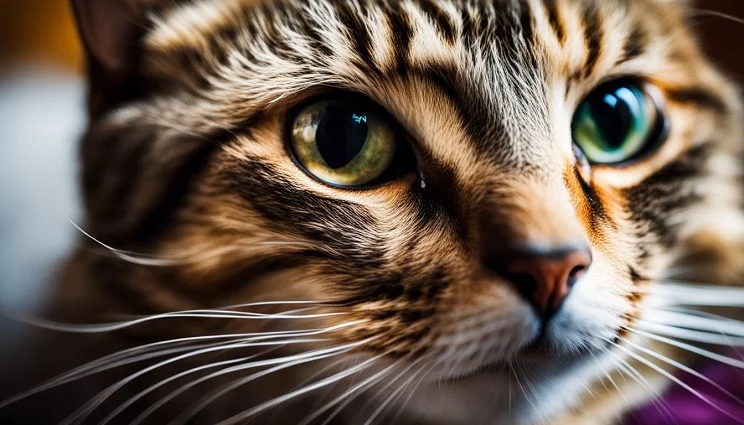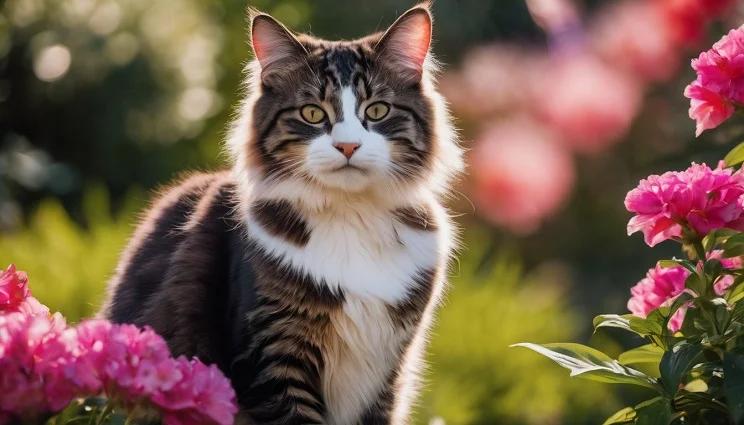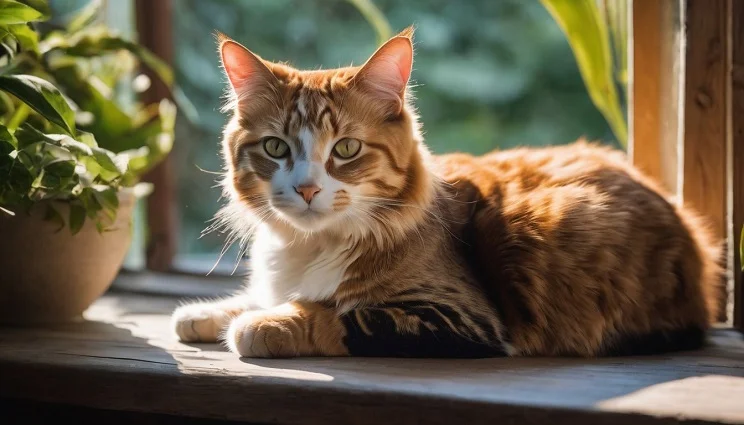Have you ever wondered what your cat is thinking when it stares at you? Cats use their eyes to share a lot about how they feel. This blog will break down the meaning behind different eye expressions your cat makes.
Key Takeaways
- Cats communicate how they feel using different eye expressions like slow blinks for love, half-closed eyes for happiness, and wide eyes when alert.
- Monitoring cat’s eyes is important to catch health issues early, such as anisocoria or conjunctivitis which need a vet’s attention.
- Understanding eye language helps in bonding with your cat by recognizing their emotions and needs through their gaze.
How Can You Tell What A Cat’s Eyes Mean?
Deciphering a cat’s eyes involves observing their slow blink of love, half-closed happy times, and the hard stare. It also includes noting full alert wide eyes with dilated pupils, overstimulated saucer eyes, and narrowed slits indicating business.
The Slow Blink Of Love
Cats show their trust and affection through slow blinking. This gesture means your cat feels content and safe around you. Think of it as a cat’s way of saying “I love you” without making a sound.
They might even use this signal to grab your attention when they want some love or comfort.
Experts believe slow blinking is a sign that cats are completely at ease in their environment. It’s like they’re giving humans a special nod, acknowledging the bond between them. So, if your cat gives you a slow blink, try returning the gesture.
It’s one of the simplest ways to strengthen the connection with your pet and show them you care right back.
Half-Closed Happy Times
A cat with heavy-lidded, half-closed eyes often feels happy, peaceful, and relaxed. This expression shows they are comfortable in their environment and with the people around them.embodying the quintessential happy cat.
Their normal pupils add to this sign of relaxation. Gazing at you like this means they trust you and enjoy your company.
Seeing a cat like this can also indicate they feel safe. They might be lying in their favorite spot, squinting gently as they observe their surroundings. It’s a way for them to express contentment without making a sound, relying on non-verbal communication to show their emotions clearly.
The Hard Stare
Cats sometimes look at you with a hard stare. This gaze can mean different things. If your cat’s pupils are small, it might be feeling angry or agitated. The meaning changes with the situation.
Cats use their eyes to show dominance too. If they keep eye contact without blinking much, they’re showing they’re in charge.
This type of stare isn’t always about power; context matters a lot. Other body language clues help figure out what your cat means by its intense look. Watching how cats use their eyes gives us insight into cat behavior without them meowing a word.
Full Alert: Wide Eyes And Dilated Pupils
Cats display round eyes with raised eyelids when in full alert, along with dilated pupils. Wide eyes and dilated pupils in cats indicate excitement or intense focus on their surroundings.
During the daytime, dilated pupils can signify alertness, which can be positive or negative.
Overstimulated Saucer Eyes
Cats get overstimulated saucer eyes with nearly-black pupils when they need a break from stimulation. Wide, dilated pupils indicate that they’re feeling overwhelmed and it’s time to create a calmer environment for them.
An important fact is that this expression reflects their need for relief from excessive sensory input.
This sign can be noticed by looking out for massive, dark-colored pupils in cats. It shows that creating a calm and quiet space could help your feline friend avoid becoming agitated or overwrought due to too much commotion around them.
Narrowed Slits Mean Business
Cats with narrowed slits mean business, displaying their focus and readiness to act. This intense gaze signals caution and potential aggression, so it’s important to approach with care when a cat has this expression.
Dilated pupils can indicate excitement, fear, or aggression, while constricted pupils might signal contentment or relaxation. Squinty eyelids protect the eyes from potential injury in offensively aggressive cats.
The Importance of Monitoring Your Cat’s Eyes for Health Issues

Monitoring your cat’s eyes is crucial for detecting potential health issues. Keep an eye out for signs of anisocoria or other common eye problems.
Anisocoria in cats means one pupil is larger or smaller than the other, indicating potential eye issues. This condition can result from various eye problems and should be closely monitored for changes in size.
An unequal pupil size, or anisocoria, requires prompt attention from a veterinarian as it signals a problem that needs professional evaluation due to its association with cat eye diseases like feline anisocoria.
Regular observation of your cat’s eyes is crucial for maintaining their overall health and well-being.
Other Common Eye Problems
Common eye problems in cats include conjunctivitis, blepharitis, cataracts, and glaucoma. These can cause symptoms such as bloodshot or red eyes, excessive tearing, squinting, sensitivity to light, and changes in the appearance of the eyes.
Anisocoria is another issue where a cat’s pupils are different sizes due to various underlying causes like head trauma or uveitis. If left untreated, these eye problems can lead to severe conditions like blindness.
Anterior uveitis in cats may result in serious complications such as cataracts and glaucoma if not promptly addressed. This underlines the critical importance of regular monitoring and prompt veterinary care for your feline friend’s ocular health.
Signs to Watch Out for
Keep an eye out for any changes in your cat’s eyes, such as excessive blinking or squinting. Sudden sensitivity to light can also indicate a potential problem. Moreover, if you notice any cloudiness in the eye or a change in color, it’s essential to seek veterinary attention promptly.
Additionally, be on the lookout for any signs of redness or discharge from the eyes, which could signal infection or inflammation.
Furthermore, pay attention to any unusual behavior related to your cat’s eyes such as rubbing their face against objects excessively or pawing at their eyes frequently. These actions may suggest discomfort and require immediate investigation by a veterinarian to prevent potential eye issues from escalating.
Understanding Your Cat’s Body Language through Their Eyes

Cats’ eyes can show their emotions and thoughts. Pupil dilation often indicates relaxation or happiness. Understanding a cat’s body language through their eyes helps in recognizing their emotions and needs.
Monitoring a cat’s eye movements is crucial for communication and bonding. The unique communication style of cats includes using their eyes to express trust, interest, and other emotions to human companions.
Conclusion
Understanding your cat’s eyes is crucial for interpreting their emotions. From slow blinks of affection to wide eyes signaling alertness, their eyes are a window to their feelings.
Monitoring your cat’s eyes can also help in identifying potential health issues early on. By recognizing and understanding your feline’s eye language, you can strengthen the bond between you and your furry friend while ensuring their well-being.
FAQs
1. What do my cat’s eyes tell me?
Your cat’s eyes can show many feelings, like being happy or anxious. If their eyes are wide open, they might be curious. Squinting or bloodshot eyes could mean your cat is not feeling well.
2. Why does my cat have a third eyelid showing?
Cats have a nictitating membrane, known as the third eyelid, which sometimes shows when they’re sleepy or if they’re not feeling good. It can also be a sign of problems like corneal ulcers.
3. Do cats communicate with their eyes differently than dogs?
Cats use their eyes differently from dogs for communication. They rely more on silent messages like slow blinking to show trust and love; whereas dogs might use more vocalizations and facial expressions.
4. How important is it to understand my cat’s eye signals?
Understanding your feline’s eye expressions helps you know how they feel and what they need from you—whether that’s food, playtime, or maybe some quiet time alone.




